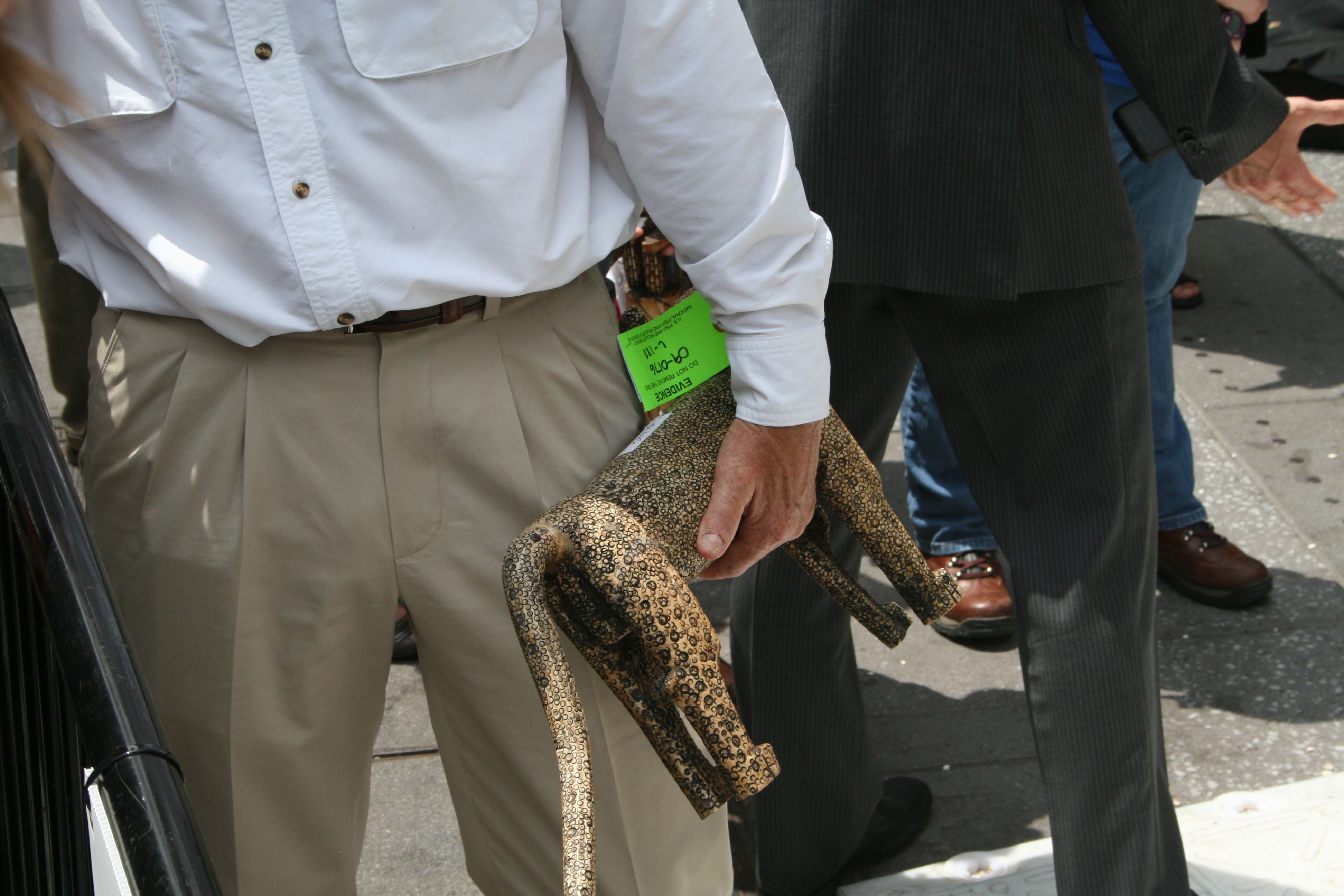Burn It? Crush It? The Historic Problem of Seized Ivory
 Confiscated ivory in Times Square on June 19th. (Photo: Heidi Ruffler/FWS/Flickr CC BY 2.0)
Confiscated ivory in Times Square on June 19th. (Photo: Heidi Ruffler/FWS/Flickr CC BY 2.0)
Last Friday, Times Square, usually a center and symbol of commerce, hosted an event dedicated to the opposite. Milling crowds snapped pictures not of electronic billboards, but of an enormous industrial rock crusher parked in front of the American Eagle Outfitters store. And instead of taking home tchotchkes, crowd members systematically picked from a pile of souvenirs and placed their chosen items on a conveyer belt that led directly into the crusher’s mouth. As the machine ground the objects into dust, the onlookers applauded.
This was no ordinary New York City afternoon—this was the Times Square Ivory Crush.
A co-production of the United States Fish and Wildlife Federation, the State of New York, and the nonprofit Wildlife Conservation Society, the event on June 19th featured thousands of spectators waving signs and dodging chunks of tusk spit out by the machine. The 2,000 pounds of ivory destroyed at the Times Square crush came in the form of carved tusks, animal statuettes, and one very elaborate two-foot boat that drew particular attention as it sailed up the conveyer belt.

Although much of it was browned and looked antique, that’s likely a result of false aging techniques dealers use to trick consumers and jack up their prices. Most of the ivory probably came from elephants killed within the last 10 years.
 John Calvelli of the Wildlife Conservation Society prepares to set a tusk on the conveyer belt at the Times Square Ivory Crush. (Photo: Julie Larsen Maher/WCS)
John Calvelli of the Wildlife Conservation Society prepares to set a tusk on the conveyer belt at the Times Square Ivory Crush. (Photo: Julie Larsen Maher/WCS)
Ivory crushes like these are part of the contemporary plan to rescue the world’s largest land mammal from the jaws of the international wildlife trafficking trade. African elephant populations are declining drastically. Habitat loss and a burgeoning illegal ivory trade have combined to reduce overall numbers by hundreds of thousands over the past quarter century. Poaching accounts for 65 percent of these deaths—bad news for the elephants, and for those African countries, like Kenya, whose economies are closely tied to safari tourism.
Ivory trafficking networks stretch across oceans and political borders—although many states and countries have already banned the sale of ivory, those who still have legal trades serve to “mask the much bigger illegal trades,” says Joe Walston, the Vice President of Global Conservation for WCS. This trade endangers not only elephants and park rangers, but the poachers themselves, who are often poor and at the mercy of the warlords, drug cartel leaders, and other international kingpins who call the shots.
One of these kingpins is Victor Gordon, the ivory dealer whose illegal stockpile was crushed on Friday. He “has never been to Africa,” reports National Geographic, but spent years hiring Gabonese smugglers to do his dirty work. On June 4, 2014, Gordon received a 30-month jail sentence after being caught during Operation Scratchoff, which “probed illegal ivory sales by a New York City jewelry distributor and two Manhattan retailers.” By contrast, poachers on the ground in Africa sometimes get life sentences, or are killed by anti-poaching squads.
 The conveyer belt at work as the crowd looks on. (Photo: Tylar Green/FWS/Flickr CC BY 2.0)
The conveyer belt at work as the crowd looks on. (Photo: Tylar Green/FWS/Flickr CC BY 2.0)
With their marriage of spectacle and activism, ivory crushes and “burns,” in which a pile of ivory products is set alight, seem tailor-made for social media: the Times Square crush featured speeches by politicians, conveyer belt photo ops for celebrity guests, and even its own hashtag, #IvoryCrush. But though they may seem built for millennial consumption, the first one actually happened 26 years ago.
In 1989, Dr. Richard Leakey, newly named director of the Kenya Wildlife Service, needed a way to draw attention to his country’s rapidly dwindling elephant population, which had decreased by half—from 1.2 million to 600,000—over only 10 years. It was a particularly crucial moment: the Convention on International Trade in Endangered Species (CITES) was set to meet that October in Switzerland to determine whether to put elephants on the international endangered species list, and thus ban ivory trade worldwide.
Rather than lobbying in the traditional way, Leakey decided to draw attention to Kenya’s poaching problem by burning the country’s entire stockpile of confiscated ivory—12 tons of tusks, worth around $3 million (the equivalent of $5.75 million today). South Africa and other countries who hoped to keep ivory trade intact decried the burn as a “publicity stunt”—which was the whole point.
 The US stockpile, ready for crushing. (Photo: Kelsey Williams/FWS/Flickr CC BY 2.0)
The US stockpile, ready for crushing. (Photo: Kelsey Williams/FWS/Flickr CC BY 2.0)
Leakey hired a Hollywood pyrotechnics expert to arrange the tusks, enlisted a Washington, D.C. lobbying firm to drum up press, and convinced Kenyan president Daniel Arap Moi to light the pyre and give a speech. “Actions speak louder than words,” Moi told the hundreds of gathered officials, journalists, and diplomats. The event made headlines worldwide, and the ban was passed.
“The idea was to communicate that ivory has no value, except to the elephant,” says Dr. Paula Kahumbu, CEO of the Nairobi-based conservation agency WildlifeDirect. “Like the PETA fur campaign in the 1960s, those who owned ivory began to feel guilty and uncomfortable, as their trinkets and jewelry represented death. The destruction led to a public shaming, and demand collapsed, leading to a drop in the price of ivory. In turn, this meant profitability for poachers. Traffickers evaporated and poaching stopped.”
The collapse in demand for ivory that followed the first ivory burn reversed when CITES allowed several countries to sell their stockpiles in 1999, and then again in 2008. Elephant numbers dropped once more—and countries who wanted to show their support for conservation started to crush in earnest. In July 2011, the Lusaka Agreement Task Force, which protects African flora and fauna, burned five tons, again in Nairobi National Park. Gabon torched its entire stockpile in June 2012, and a year later, the Philippines became the first country outside of Africa to destroy theirs—after clean air groups objected to a public burn, government officials hacked up the tusks with backhoes and saws, and then incinerated them in a crematorium.

An unknown person of importance lines up to destroy a piece of ivory in Times Square. (Photo: Cara Giaimo/Atlas Obscura)
Denver crushed six tons in November 2013 (a few months after President Obama established a task force to address wildlife trafficking), and China pulverized exactly one-tenth of a ton more in January 2014. Chad, which has lost an estimated 97 percent of its elephants over the past 50 years, threw its hat in the ring in 2014, as did France. That same year, Hong Kong began a quieter process, burning its 28-ton stockpile bit by bit in private.
The U.S. crushes ivory because it’s more efficient and effective than burning it. U.S. National Wildlife Forensics Lab tests have proven it can take months for ivory that is set on fire to be totally destroyed. Fires in Nairobi and elsewhere are guarded day and night until they burn all the way out, for fear that poachers will come and re-steal the ivory. On Friday, Times Square sounded and smelled like a stone-cutting factory, and pigeons pecked at ivory fragments littering the ground.
If 2013 set the pace for ivory destruction, 2015 is keeping up. In addition to the Times Square crush, this year has seen burns in Congo-Brazzaville and Ethiopia, as well as Kenya’s largest ever—15 tons, the start of what President Uhuru Kenyatta promises will be complete stockpile eradication by the end of the year.
Contemporary organizers are quick to point out that a burn can’t really untangle, let alone solve, the complex problems of the ivory trade. But criticizing ivory crushes for not directly reducing demand for ivory, Walston says, is “like criticizing a car for not making coffee in the morning.” Instead, they’re “a symbolism of commitment [that] needs to be followed up by action.”
The past few years have seen many African countries becoming a “stronger voice in the international community about this,” says Walston, with strong new anti-poaching laws in the most afflicted countries. Now, even holdouts like China–where a huge portion of ivory from recently poached elephants ends up–are announcing unilateral ivory trade bans. The Times Square crush was designed to be another symbolic blow. “If one of the world’s great consumer nations in one of the greatest consumer cities makes a show that it’s no longer willing to consume ivory,” Walston explains, “that becomes a very powerful statement.”
A statement that is, by design, difficult to miss. As one #IvoryCrush spectator said, “Now they just have to bring the elephants back to life.”
 The remains, which will be made into a memorial. (Photo: Tylar Greene/FWS/Flickr CC BY 2.0)
The remains, which will be made into a memorial. (Photo: Tylar Greene/FWS/Flickr CC BY 2.0)

















Follow us on Twitter to get the latest on the world's hidden wonders.
Like us on Facebook to get the latest on the world's hidden wonders.
Follow us on Twitter Like us on Facebook